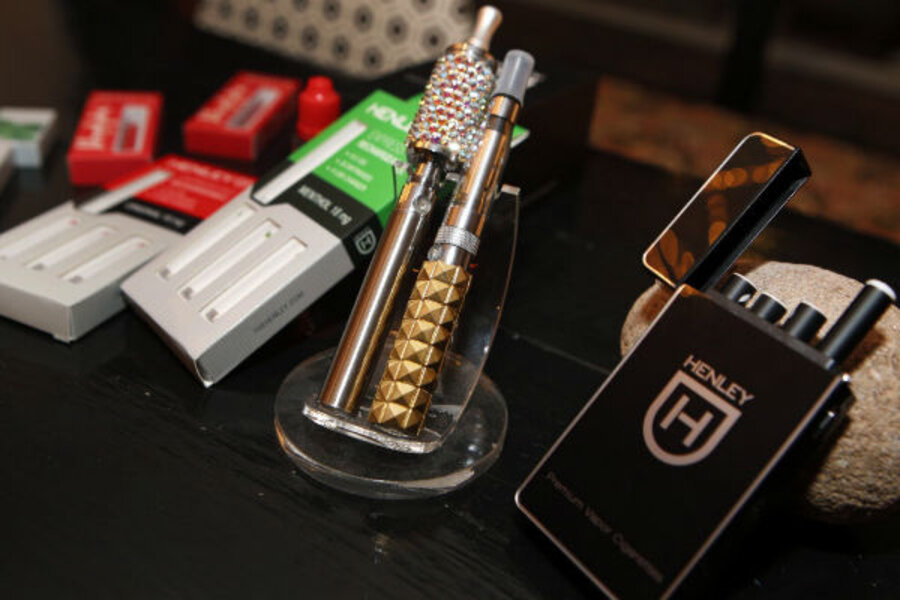Can leafless e-cigarettes be regulated as a tobacco product? FDA says yes.
Loading...
Obama administration officials, seeking to justify a new plan to regulate tobacco-less electronic cigarettes under a federal law governing tobacco products, on Thursday enumerated unanswered questions about e-cigarettes' possible health consequences and noted their rising popularity among teenagers and young adults.
The products, whose use has been soaring in the US (including among smokers who are trying to kick the cigarette habit), deliver nicotine via a liquid solution. Nicotine is derived from tobacco, although electronic cigarettes do not contain tobacco leaves as found in combustible cigarettes.
The federal government defines a tobacco product as any “product made or derived from tobacco that is intended for human consumption.” The Food and Drug Administration (FDA) wants to extend oversight to several unregulated products that it says meet that legal definition, including e-cigarettes, pipe tobacco, nicotine gels, and cigars.
“Today with the new proposed FDA rule on deeming [e-cigarettes a tobacco product], we’re taking another very important step toward the goal of a tobacco-free generation,” Health and Human Services Secretary Kathleen Sebelius told reporters Thursday during a phone press conference.
If the FDA rule becomes final, its first impacts would be to require electronic cigarette companies to register their products with the agency, to disclose the ingredients in the liquid nicotine solution, to seek FDA approval of all direct or implied claims of reduced risk to human health, and to stop distributing free samples.
The rule would also immediately restrict the sale of e-cigarettes to minors, a move that at least 33 states have already made. Some electronic-cigarette manufacturers, such as blu eCigs of Charlotte, N.C., already have self-imposed minimum age requirements on their direct Internet sales.
Additional regulations would go into effect two years after the rule becomes final. At that time, companies would be required to affix a nicotine addiction warning to all e-cigarette packages and would not be able to bring new products to market without prior FDA approval. The FDA would then also be able to impose additional regulations, such as restrictions on flavorings added to the nicotine solution. Antismoking advocates argue that flavored tobacco products make them more attractive to children.
The Smoke Free Alternatives Trade Association, a trade group representing electronic cigarette makers, said in a statement Thursday that the industry welcomes FDA regulation. A separate statement on the SFATA website, however, notes that under excessive regulation “this new and innovative industry will be squelched, the marketplace will be less vibrant and consumers will lose.”
Blu eCigs President Jason Healy argues that as long as regulations are based in scientific evidence, their effect will be overwhelmingly positive for the both the consumer and the industry.
Blu eCigs already meets several proposed regulations, including restricting sales to minors on blucigs.com and disclosing ingredients on the packaging, Mr. Healy says in a phone interview. He is skeptical that scientific evidence will reveal harm from adding flavoring to the nicotine solution, but says he would comply with restrictions if studies suggest that is the case.
Healy expects that scientific review of e-cigarettes will confirm “that e-cigs offer a huge potential for harm reduction. We are talking about something that does not use combustion and does not burn a leaf, and that’s where most of the constituents and carcinogens come into play with traditional cigarettes.”
While some users and public health experts suggest that e-cigarettes could be safer for human health than combustible cigarettes, the FDA’s Mitch Zeller, director of the Center for Tobacco Products, cautions that little is known about their contents and health effects.
“When it comes to e-cigarettes, it’s the wild, wild West,” Mr. Zeller said during the Sebelius conference call with reporters. “We can’t even tell you what the compounds are in the vapor, and in the absence of regulation the companies aren’t required to give us any information.”
While a product that delivers nicotine without burning tobacco might reduce health risks for individuals who have no intent of kicking their addiction to the nicotine, e-cigarettes may yet prove to be a gateway for young people to develop new nicotine habits, Zeller says.
“We know that the use of novel products, like the so-called e-cigs, are on the rise, particularly among young people. CDC [Centers for Disease Control] has found, for example, that the use of e-cigarettes among middle and high school students doubled between 2011 and 2012,” Ms. Sebelius told reporters. “What we don’t know yet is the full impact of ramifications that these products have on our nation’s health.”
Zeller and Sebelius hope that bringing FDA oversight to electronic cigarettes will prompt new studies that can provide more answers about the effects of these new products on public health.
Zeller also raised safety concerns beyond the health consequences of ingesting vaporized nicotine.
“We have e-cigarettes that are exploding in car chargers and wall sockets. We have people purchasing liquid e-nicotine cartridges, and it’s buyer beware. None of this is taking place in a regulated environment, and that’s why we are proposing this rule.”
In recent months, several electronic cigarettes have exploded or caused fires. In February, the CDC recorded 215 calls to poison control related to e-cigarette exposure.






